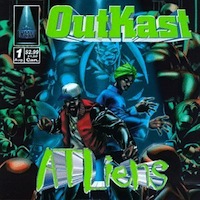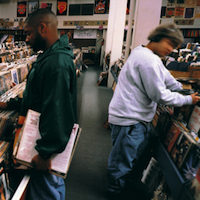Top 100 Hip-Hop Albums of the ’90s: 1995-1999

 10. Bahamadia – Kollage
10. Bahamadia – Kollage
(Chrysalis)
Buy at iTunes
Two rap scenes hit a turning point in 1996: This was the last year for jazz rap to really make any sort of noise, and the city of Philadelphia was on the verge of being overrun by “Big Willie Style.” Under the radar and yet on target to help both was Bahamadia, a Philly girl who was part of Gang Starr Foundation, acts loosely affiliated with Guru and DJ Premier most notably including Dream Warriors and Jeru the Damaja. The thing that sets her debut Kollage apart from releases by her female contemporaries is her flow; some ladies try to match a male-dominated gangsta lean, others try to coo their way into your pants, but listening to Bahamadia is all about her hypnotic, syrupy monotone, words be damned. That sells short the verbal gymnastics actually going on in the cracking tracks that are here, among them the one-two punch of “Wordplay” and “Spontaneity” (which would have done Digable Planets proud), swirling early singles “3 the Hard Way” and “Uknowhowwedu,” as well as “Da Jawn,” produced by the nascent Roots and helping to introduce a grateful nation to the notion of, well, da jawn. Sadly, one wonders what could have been with a bit more push by the Chrysalis label, by Guru, by who the heck knows—her biggest fanbase is in Japan, and her biggest hit may have been the title track for Roni Size’s drum’n’bass epic New Forms. – Adam Blyweiss
 9. The Roots – Illadelph Halflife
9. The Roots – Illadelph Halflife
(DGC)
Buy at iTunes
The Roots always did things a little bit differently than their contemporaries and their third full-length, Illadelph Halflife is proof of that. In 1996, the rap battle between West and East Coast rappers had reached a fever pitch, with artists of all backgrounds claiming some semblance of allegiance to one side or the other. But The Roots never succumbed to allowing the drama of other MCs to creep onto their record. Instead, Illadelph Halflife showcased the group’s ability to operate on a higher lyrical level without sacrificing intensity. At the same time they were breaking down the clichés and stereotypes that existed in the rap game with tracks like “Clones” and “What They Do.” Musically, The Roots were on a different level than the rest of hip-hop. Eschewing the standard formula for hip-hop of two turntables and a microphone, The Roots employed a full band, whose sound was finally fully realized on Illadelph Halflife. Jazzy undertones combined with an R&B flavor (thanks to guests like D’Angelo, Raphael Saadiq and others) and hypnotic beats courtesy of ?uestlove to create a smoky and sultry throwback album that kept one foot in the present. – Ryan Brun
 8. Ghostface Killah – Ironman
8. Ghostface Killah – Ironman
(Epic)
Buy at Insound
Chock full of soul samples from Al Green, O.V. Wright and Otis Redding, and the vocals provided by the Delfonics on “After the Smoke is Clear,” Ghostface Killah’s debut album, Ironman, has a much lighter tone, musically, than previous Wu-Tang affiliated releases. Lyrically, however, it’s still relentless as ever. Raekwon’s solo track “The Faster Blade” displays RZA’s gifted production style yet again as he has the range to accommodate every member of the clan. On “260,” Al Green’s “You Ought to Be With Me” is matched with a minimalistic looping beat to Ghostface and Raekwon’s narrative about robbing some coke dealers, showcasing how the soulful approach meshes well with the fierce, Wu-Tang lyrical style. Even though it’s technically Ghostface’s debut album, Raekwon and Cappadonna’s names are also on the cover and are frequently featured on several tracks, while other members like Method Man, RZA and U-God also appear. Ghostface’s clear-eyed storytelling takes center-stage on his “solo” debut as he sets the scene detailing his childhood struggles on “All That I Got Is You,” and Mary J. Bilge singing the chorus makes for the most tenderly memorable track on the record. – Dan Pritchett
 7. UGK – Ridin’ Dirty
7. UGK – Ridin’ Dirty
(Jive)
Buy at iTunes
The full maturation and realization of Bun B and Pimp C’s talents, Ridin’ Dirty also stands for the maturation of the Texas hip-hop scene into an identity beyond what the Geto Boys had established. The duo had been together for several years, releasing cassettes and singles, but this album’s production is so richly textured and varied, the deliveries of the two are so well contrasted, and the rhymes more sophisticated than their past pieces, which were more promises of talent than actual statements. And this album is definitely a statement. Their own laid-back approach to funk perfectly tempers the aggression and hyperactive creative energies seen from many peers of this time, and already having introduced “trill” as a part of Southern hip-hop’s unique lexicon, this album goes on to introduce pinky rings, codeine and other Third Coast staples, all the more taking the initiative in establishing Southern rap’s Western front. Standing in tandem with an emerging OutKast in the southeast, the South had enough to rival burgeoning East and West coast scenes that were dominating headlines with 2pac and Biggie, Dr. Dre and Snoop Dogg, Jay-Z and Nas. This album sets the early bar for southern rap, and makes it easy to see (and hear) why the Third Coast moniker is more than warranted. – Justin Stephani
 6. De La Soul – Stakes Is High
6. De La Soul – Stakes Is High
(Tommy Boy)
The elitist-sounding term “conscious hip hop” implies that other forms of the genre lack respect for what should be important issues. On Stakes Is High, De La Soul take that implication and expand it into a full-blown assailment on what they see as an increasingly sexualized, superficial, and violent culture — subject matter that ticked-off gangster rap flag-bearer 2Pac enough to lash out at De La on a track that only got released after 2Pac died from a shooting (karma may be too strong a word, but come on). Rapper Dave sums up his frustrations and sews the seeds for the beef with what seem like banalities in hindsight: “Sick of swoll’ head rappers with their sicker-than raps / Clappers and gats makin’ the whole sick world collapse.” Lyrical consistency was something you could count on with De La Soul but the production was a big question mark going into Stakes Is High, considering it would be the first album without their sample innovator and quasi-fourth member, Prince Paul. De La Soul bear most of the production weight on their own shoulders and to surprisingly spectacular results — “Wonce Again Long Island,” “Itzsoweezee (HOT)” and “Sunshine” are among the group’s all-time catchiest tunes. If that weren’t enough, the title track happens to be one of J Dilla’s greatest and earliest creations. The album may not have sold well, but both lyrical and instrumental substance earn this LP a well-deserved spot on the list. – Donny Giovannini
 5. Dr. Octagon – Dr. Octagonecologyst
5. Dr. Octagon – Dr. Octagonecologyst
(Bulk)
Buy at Insound
Kool Keith rose straight to the top of the underground hip-hop class in the 1980s as a member of Ultramagnetic MCs, but when he entered the ‘90s, dude took rap into some strange and surreal places. At various points in time he took on various aliases, such as grossout horrorcore villain Dr. Dooom or sci-fi superstar Black Elvis. Yet his crowning moment was Dr. Octagon, an alien horror flick collaboration with Dan the Automator that yielded a series of free-association raps from the character of Doc Oc, a maniacal extraterrestrial with an M.D. and a penchant for lyrical skills (and the occasional snippet of dialogue from porno films). For his money, Automator provides much of the essential atmospheric context here, dropping some thick synth funk on “Earth People” and chilly crackly strings on “Blue Flowers.” At the time this was uncharted territory for hip-hop and still sounds pretty damn weird, in all the best ways. Think the streets sound dangerous? You’ve obviously never been to Dr. Octagon’s home planet. – Jeff Terich
 4. Outkast – ATLiens
4. Outkast – ATLiens
(LaFace)
Buy at Insound
There are few MC duos throughout hip-hop that possess the outright skill of Outkast’s Big Boi and Andre 3000. While they established their tongue-twisting verbal sparring on their debut record, it wasn’t until their sophomore effort, ATLiens, where they really came into their own. Lyrically, both Big Boi and Andre stepped their game up, largely leaving behind the boastful nature of their previous album in favor of a more personal approach. Andre 3000 had quit drinking and drugs prior to recording the album, which in turn was reflected in his verse on “ATLiens” where he raps “No drugs or alcohol so I can get the signal clear as day/Put my Glock away I got a stronger weapon/That never runs out of ammunition so I’m ready for war okay.” With ATLiens, Andre’s newfound clarity combined with Big Boi’s tendency to toe the line between playa and gentleman and it was the true beginning of a special duo that would contradict yet complement one another for years to come. – Ryan Brun
 3. Fugees – The Score
3. Fugees – The Score
(Ruff House/Columbia)
Buy at Insound
Three minds coming together at the peak of their precocious, buoyant young adulthood, right before things so sublimely fell apart. Energy and confidence oozes out of every pore of this album, as the best relatively no-name crew rolling around New York at that time exploded in popularity because of “Killing Me Softly,” and simultaneously imploding, the same raw energy and intensity that created this artistic masterpiece also straining the group (pretty much just Lauryn Hill and Wyclef Jean) way, way, way beyond their breaking point emotionally, personally, physically. But not before they satirized most of the hip-hop game (e.g. riffing off of Wu-Tang’s martial arts-obsessed skits) while positing their own thoughts on African-American strife. It’s all the makings of a classic hip-hop album, and yet, it’s all utterly overshadowed by some of the most jaw-dropping performances from Lauryn Hill. And I’m talking about her rapping. On second thought, forget the era, forget the ’90s—on The Score, Hill drops some of the most technically proficient verses you will ever hear. And some of the most timeless as well, or was I the only one bringing back the “like Newt Gingrich sucks dick” line during the Republican primaries in 2012? – Justin Stephani
 2. DJ Shadow – Endtroducing…
2. DJ Shadow – Endtroducing…
(Mo’Wax/London)
Buy at Insound
Long ago and far away, Godfather of Soul (and sampling sperm-donor of rap) James Brown made the simple request to “give the drummer some,” highlighting the rhythm that gave weight to musicians’ words. In his world that meant a solo or an instrumental break. For rap DJs the spotlight was rarely handed to them, they needed to take it—Grandmaster Flash merging Blondie and Chic and Queen on the wheels of steel, DJ Premier constructing sentences in deep concentration, Terminator X to the edge of panic. Josh Davis spent the late 1980s and early 1990s standing on the shoulders of these giants, making and promoting beats he and his cronies built in Northern California. Visits to Rare Records in Sacramento brought Davis in contact with the unheralded vinyl that would eventually yield the samples with which he would solidify his legacy as DJ Shadow. Other DJs had released their own albums of rhythms prior to Endtroducing…, but most were sets of streetwise Jeep beats and conveyances for guest rappers. DJ Shadow really stood turntablism on its own two feet, and then on its head, by creating a world of his own from words on up using MPC, turntable, and DAT recorder. The results of Shadow’s time-stretching, glitching, bits of dialogue, and strategically selected atmospheric sounds not only shone new light on how DJs could define hip-hop (“The Number Song,” “Midnight in a Perfect World“) but snaked into smoky R&B (“What Does Your Soul Look Like [Part 1 – Blue Sky Revisit]”), drum’n’bass (“Napalm Brain/Scatter Brain”), and minimal funk (“Organ Donor”). Tied together by staticky time-travel interludes, closed out with a Twin Peaks sample, and frankly just observing how DJ Shadow built what had not existed before, Endtroducing… isn’t just a hip-hop album. It’s science fiction made real through sound. – Adam Blyweiss
 1. Jay-Z – Reasonable Doubt
1. Jay-Z – Reasonable Doubt
(Roc-a-Fella)
Buy at Insound
There are exactly two flaws on Reasonable Doubt: 1. The annoying Tony Montana impersonator that begins the record (and then shows up in a reprisal of his role on “Brooklyn’s Finest”); and 2. “Ain’t No Nigga,” the odd-man-out sex rap that stands out as a moment of blatant commercialism. The remaining 13 tracks can go toe-to-toe with any full-length of the decade, or Jay-Z’s career, at least matching if not besting The Blueprint. But looking at his current output, it’s astounding how long it’s been since Jay-Z (sorry… Jay Z) sounded this hungry and on-point. Currently occupied with performance art films and releasing a Samsung-distributed album that’s, appropriately, mostly phoned in, the Jay-Z of 2013 scarcely resembles the young hustler who claimed Brooklyn as his own 17 years earlier.
On Reasonable Doubt, Jay maintains an unflappable cool, effortlessly weaving in and out of crime narratives with reflections on the process of rising to the top, and the negative effects of doing so. Not so much “conscious rap” as hardcore with a conscience, Reasonable Doubt paints a gritty picture without being distracted by cartoonish gangsterisms (you know… except for that Montana sound-alike). Aided by an all-star team of producers (Ski, The Hitmen, DJ goddamn Premier) Jay takes the listener on a guided tour of street realism and Mafioso ambition, offering some of the best tracks of his career, including “Can’t Knock the Hustle,” “Can I Live” and “Dead Presidents II.” It actually wouldn’t take that much time before Jay actually did rise to the top, but from the beginning, he was already scoping the real estate. – Jeff Terich

